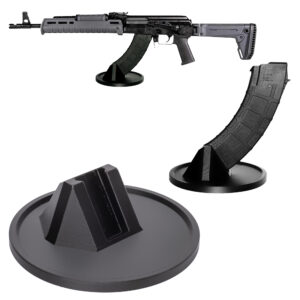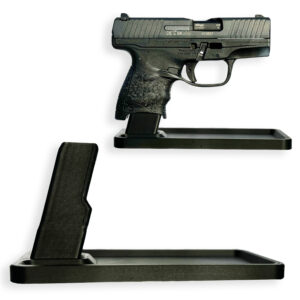Categories:
The AR-15 is a quintessential piece of modern guns technology, renowned for its versatility, modularity, and performance. Central to the operation of the AR-15 is its gas system, a critical component that harnesses the energy generated by firing a round to cycle the action, facilitating semi-automatic fire. Understanding the AR-15 gas system requires delving into the mechanics that make this process both reliable and efficient, with the gas block serving as a pivotal element in this orchestration.
When a round is fired, the propellant ignites, creating a high-pressure environment that propels the bullet forward through the barrel. As the bullet travels down the barrel, it passes a small gas port, an aperture that allows a portion of the high-pressure gas to be diverted from the barrel and directed into a gas tube. This diverted gas is harnessed to perform the crucial task of cycling the action.
The gas tube channels this pressurized gas back toward the receiver, where it enters the gas key atop the bolt carrier group. The force applied by the gas pushes the bolt carrier rearward, ejecting the spent cartridge and preparing the gun to chamber a new round. At the heart of this gas diversion process is the gas block, mounted directly over the gas port on the barrel.
The role of the gas block extends beyond merely routing gas; it regulates the flow and pressure of the gas to ensure that the action cycles smoothly and reliably. This regulation is paramount, as excessive gas flow can lead to increased wear and tear on components and erratic cycling, whereas insufficient gas flow can cause malfunctions or failure to cycle properly.
Adjustable gas blocks allow for fine-tuning of the gas flow, accommodating various ammunition types and operating conditions, thus optimizing performance. The efficiency of the AR-15 gas system underscores the importance of each component working in harmony. From the initial ignition of the round to the ejection of the spent case and the chambering of a new round, the gas system’s orchestration showcases engineering prowess.
In essence, the AR-15 gas block exemplifies the delicate balance of precision and power, ensuring the weapon operates with the reliability and effectiveness for which it is renowned.
A gas block is a crucial component of the AR-15 rifle’s gas system that plays a key role in its semi-automatic function. Located on the barrel of the rifle, the gas block manages the flow of gas that is generated when a round is fired. This gas is essential for cycling the action, meaning it ensures the rifle can automatically load the next round into the chamber without manual intervention.
Understanding how a gas block works can provide valuable insight into the mechanics of the AR-15 and why it is a popular choice for shooters and enthusiasts.
The process begins when a round is fired, creating high-pressure gas in the barrel. This gas travels through a small hole called the gas port, which is strategically positioned on the barrel. The gas then enters the gas block, which acts as a channel, directing the gas into a tube that leads directly back to the bolt carrier group. The gas pressure forces the bolt carrier group backward, extracting the spent cartridge from the chamber and ejecting it out of the rifle.
This movement also compresses the buffer spring, which then pushes the bolt carrier group forward again, chambering a new round in the process.
Gas blocks come in various designs and functionalities, offering different levels of performance and adjustability. Some gas blocks are fixed, meaning they are set to allow a specific amount of gas through and cannot be adjusted. Others are adjustable, giving the user the ability to fine-tune the amount of gas that is directed back to the bolt carrier group. Adjustable gas blocks can be particularly advantageous for those who use suppressors or different types of ammunition, as these can alter the gas pressure that the rifle needs to function optimally.
Overall, the gas block is a fundamental part of the AR-15’s operating system. It ensures that the rifle operates smoothly and reliably, which is crucial whether the gun is being used for hunting, competition shooting, or self-defense. Its role in regulating gas flow underscores the importance of maintaining and, if necessary, upgrading this component to ensure the AR-15 meets the specific needs and preferences of the user.
The AR-15 gas block is a crucial component in an AR-15 rifle, as it regulates the gas flow from the barrel to cycle the action. Different types of AR-15 gas blocks are available, each suited to various needs and preferences of gun enthusiasts. A common type is the fixed gas block. These gas blocks are non-adjustable and designed to provide a consistent level of gas flow to ensure reliable cycling of the action.
They are typically uncomplicated and effective for standard shooting applications, offering a set-and-forget reliability that appeals to many users, especially new gun owners and those using their rifles for general-purpose shooting. Adjustable gas blocks, on the other hand, allow the shooter to fine-tune the amount of gas that reaches the action. This adjustment capability is particularly beneficial for those using suppressors or running different types of ammunition, which can create varying amounts of gas pressure.
Suppressed shooting often increases gas blowback, leading to an over-gassed system. An adjustable gas block can mitigate this by reducing the gas flow, improving reliability, and decreasing wear on the rifle. Similarly, for competition shooters who frequently use custom loads, these blocks enable a level of control that ensures optimal performance. Low-profile gas blocks are another popular option, especially useful for those who install free-floating handguards.
These gas blocks are designed to fit underneath the handguards, offering an unobtrusive means of gas management. They are smaller and lighter than traditional fixed front sight bases, contributing to a sleeker, more modern aesthetic, and providing compatibility with a broader range of handguard styles and lengths. Furthermore, clamp-on gas blocks provide an alternative to traditional pinned or set screw models.
Clamp-on gas blocks are attached to the barrel by clamping around it, which can be beneficial for those concerned about marring their barrel or looking for a more secure attachment method. They offer good stability and are easier to install or adjust without specialized tools. Each type of gas block has its specific use cases and advantages, giving shooters a range of options to tailor their AR-15 rifles to their specific needs, whether for tactical use, hunting, competition, or recreational shooting.
The gas block in an AR-15 rifle plays a crucial role in regulating the gas flow from the barrel to ensure proper cycling of the action. When a round is fired, high-pressure gas is generated in the barrel as the bullet travels forward. This gas needs to be harnessed to operate the semi-automatic mechanism of the rifle. The gas block serves as the conduit through which a portion of these gases is redirected.
Positioned over a small hole in the barrel known as a gas port, the gas block channels some of the pressurized gas into a gas tube, which then directs it back towards the bolt carrier group.
The primary function of the gas block is to manage the amount of gas that enters the gas tube. Accurate regulation is essential to maintaining the rifle’s reliability and performance. If too much gas is directed back, it can lead to excessive wear on the rifle components and increase the felt recoil, making the rifle more difficult to control. On the other hand, if too little gas is allowed through the gas block, the rifle may fail to cycle properly, leading to issues like failure to eject spent casings or chamber a new round.
Gas blocks come in various types, including fixed and adjustable models. Fixed gas blocks allow a predetermined amount of gas to pass through, which generally offers a balance suitable for a wide range of ammunition types and conditions. However, adjustable gas blocks provide the shooter with the ability to fine-tune the gas flow based on specific needs. By turning a screw or dial, the shooter can increase or decrease the orifice size within the gas block, thereby controlling the gas volume that reaches the gas tube.
The benefit of using an adjustable gas block becomes particularly evident when using suppressors, different loads of ammunition, or when precision tuning is desired for competition shooting. The ability to adjust the gas flow can result in a smoother shooting experience, reducing recoil and wear while improving overall reliability and longevity of the gun. Thus, the gas block serves as a pivotal component in the AR-15’s gas-operated system, ensuring that the gun functions smoothly and efficiently.
Adjusting the gas block on an AR15 is a crucial task for ensuring optimal performance and reliability of the gun. The gas block regulates the amount of gas that flows from the barrel into the gas system, which in turn cycles the action. By precisely adjusting the gas block, you can fine-tune the rifle to suit your specific needs, whether it be for competitive shooting, hunting, or personal defense.
To begin with, understanding the factory settings of your AR15 is essential. Most rifles come with a gas block that is set to a standard configuration, which is generally suited for a variety of ammunition and conditions. However, the factory setting might not be optimized for your specific use case or may not accommodate aftermarket modifications such as a suppressor or different barrel lengths.
To adjust the gas block, you will first need to ensure that your rifle is safe and unloaded. Disassemble the gun according to the manufacturer’s instructions to access the gas block, which is typically located on the barrel near the front sight or handguard. Once you have clear access, you can begin to make fine adjustments. Starting with the gas block in its current position, fire a few rounds and observe how the rifle cycles.
Pay close attention to the bolt carrier group and note any issues, such as failure to eject or feed, and the felt recoil. Using a small hex wrench or Allen key, you can incrementally open or close the gas port. If the rifle fails to cycle properly, this usually indicates that the gas port is too closed, and you will need to allow more gas to flow into the system.
Conversely, if the recoil feels excessively harsh or you notice the bolt carrier group slamming back too forcefully, the gas port may be allowing too much gas, and you will need to reduce the flow. Test fire after each adjustment while ensuring that each shot cycles the action reliably. It can be helpful to clean the rifle and use consistent ammunition throughout this process to maintain uniform testing conditions.
Record your adjustments and results to fine-tune the settings further if needed.
When dealing with an AR-15 gas block, several common issues can arise that may affect the gas flow from the barrel necessary to cycle the action. One frequent problem is gas block misalignment. If the gas block is not perfectly aligned with the gas port on the barrel, the gas flow can be restricted, leading to cycling issues such as failure-to-feed, failure-to-eject, or stovepiping.
Misalignment can occur due to improper installation or shifting during use. Ensuring that the gas block is correctly positioned and securely fastened can alleviate these problems. Another issue is carbon fouling. Over time, carbon deposits can build up in the gas block and gas tube due to the combustion of gunpowder. This fouling can obstruct the passage of gas, resulting in reduced efficiency of the gas system.
Regular cleaning of the gas block and gas tube is essential to prevent carbon build-up. Using appropriate cleaning tools and solvents can help maintain the optimal performance of these components. The choice of gas system length—carbine, mid-length, or rifle—can also impact gas flow and cycling reliability. Using an inappropriate gas system length for the barrel can create excessive or insufficient gas pressure, leading to inconsistent cycling.
Consulting the manufacturer’s recommendations for barrel length and gas system configuration can help avoid such mismatches. Leaks at the gas block or gas tube can also cause cycling issues. Gas leaks can arise from improperly tightened screws, damaged O-rings, or worn-out seals. Tightening all fasteners and replacing any damaged components are simple methods to ensure that the gas system is properly sealed.
Using incorrect ammunition can likewise result in poor performance. Ammunition with inadequate or excessive pressure characteristics can fail to provide the necessary gas pressure to cycle the action smoothly. Stick to recommended ammunition specifications to ensure reliable functioning. Lastly, some aftermarket gas blocks feature adjustable settings. Improper adjustments can either starve or oversaturate the system with gas, causing reliability issues. Verifying and fine-tuning adjustable gas blocks based on performance feedback is crucial for optimal functionality.
Recognizing and troubleshooting these common issues with AR-15 gas blocks can significantly enhance the gun’s reliability and longevity.
Proper maintenance and periodic upgrading of your AR-15 gas block are crucial to ensure the reliability and performance of your gun. The gas block plays an integral role by regulating gas flow from the barrel to cycle the action, and as such, it must be kept in optimal condition. To begin with maintenance, regular cleaning of the gas block is essential.
Carbon build-up from fired rounds can obstruct the gas passage, leading to poor cycling or even complete failure. Disassemble the gas system carefully, making sure to remove all the accumulated carbon and debris from the gas port, gas tube, and the block itself. Use a carbon scraper or a cleaning solution that is designed for guns to assist in removing stubborn residues.
Inspect the gas rings and replace them if they show signs of excessive wear or damage, as compromised gas rings can lead to gas leaks and decreased performance. Checking the alignment of the gas block is another key aspect of maintenance. Misalignment may lead to erratic cycling or gas leakage. After cleaning, when reassembling the gas block, ensure it is precisely aligned with the gas port on the barrel.
A misaligned gas block can lead to inefficient cycling and possible damage to other components of the gas system. Secure the gas block with appropriate fasteners and tighten them to the recommended torque specifications to prevent any loosening during operation. When it comes to upgrading, several factors might necessitate an enhanced gas block. Your shooting style, ammunition preferences, or even specialized use cases, such as suppressor use, may dictate different gas flow requirements.
Upgrading to an adjustable gas block allows for fine-tuning the gas flow to suit specific needs, reducing recoil, and improving cycling reliability with various types of ammunition. Moreover, a low-profile gas block could be a beneficial upgrade if you plan on installing a new handguard or other barrel-mounted accessories, as these gas blocks provide necessary clearance and compatibility. Furthermore, advancements in materials and coating technologies have resulted in gas blocks that are more durable and corrosion-resistant.
Consider upgrading to a gas block made from high-grade steel or with a nitride finish for enhanced longevity and performance, especially if you frequently shoot in harsh environments.








Colt
Colt M4 Carbine
Colt LE6920
Colt AR-15 A4
Daniel Defense
DDM4 V7
DDM4 V9
DDM4 V11
DDM4 ISR (Integrally Suppressed Rifle)
Smith & Wesson (S&W)
M&P15 Sport II
M&P15 Tactical
M&P15T
Bravo Company Manufacturing (BCM)
BCM Recce-16
BCM Recce-14
BCM MCMR Series
Aero Precision
M4E1 Series
AC-15
AR15 Pistol (Various Configurations)
Ruger
Ruger AR-556
Ruger SR-556
Ruger AR-556 MPR (Multi-Purpose Rifle)
Springfield Armory
Saint Victor
Saint Edge
Saint AR-15
PSA (Palmetto State Armory)
PSA PA-15
PSA AR-V
PSA Jakl (AR Pistol)
FN America
FN 15 Tactical Carbine
FN 15 Patrol
FN 15 DMR
Wilson Combat
Recon Tactical
Super Sniper
Protector Carbine
SIG Sauer
SIG M400 Tread
SIG M400 Elite
SIG M400 SDI
LWRC International
IC DI (Direct Impingement)
IC SPR
IC A5
Bushmaster Guns
XM-15 QRC
Bushmaster MOE
XM-15 Patrolman
Rock River Arms
LAR-15 Entry Tactical
LAR-15 Predator
LAR-15 Elite Comp
Stag Arms
Stag 15 Tactical
Stag 15L (Left-Handed Models)
Stag 15 Valkyrie
Noveske Rifleworks
Noveske Gen 4 N4
Noveske Space Invader (AR Pistol)
Noveske Recon
Anderson Manufacturing
AM-15 Optic Ready
AM-15 M4 Carbine
AM-15 Precision Rifle
Adams Arms
AA-15 Piston Rifle
P2 AARS (Adams Arms Rifle Series)
Black Rain Ordnance
SPEC15 Series
BRO Predator
Fallout 15
Diamondback Guns
DB15 Series
DB15CCMLB
DB15EB
Del-Ton Inc.
DTI-15
Del-Ton Echo 316H
Sierra 316M
Windham Weaponry
Windham SRC
Windham VEX-SS
Windham RMCS-4 (Caliber Conversion System)
Christensen Arms
CA-15 G2
CA-15 Recon
CA-15 Titanium Edition
Patriot Ordnance Factory (POF-USA)
Renegade Plus
P415 Edge
Revolution DI
LaRue Tactical
PredatAR
OBR (Optimized Battle Rifle)
LaRue Stealth 2.0
Battle Arms Development
Workhorse Patrol Carbine
BAD556-LW (Lightweight)
Authority Elite Rifle
Faxon Guns
Ascent AR-15
FX-19 (AR Pistol)
Streamline Ultralight Series
KE Arms
KE-15 SLT (Super Lightweight Tactical)
KE-15 Scout Carbine
Primary Weapons Systems (PWS)
MK1 MOD 2-M
MK116 PRO
MK107 (Piston AR Pistol)
ZEV Technologies
ZEV Core Elite Rifle
ZEV AR15 Billet Rifles
Franklin Armory
BFSIII AR-C1
Militia Model
F17-L (Chambered in .17 WSM)
Seekins Precision
SP15 DMR
NX15 Skeletonized Rifle
Havak Bravo
Aero Precision (Additional Models)
EPC-9 (Pistol Caliber ARs)
VG6 AR Rifles
Barrett Guns
REC7 DI
REC7 Gen II
CMMG
MK4 RCE
Resolute 300
Banshee (AR Pistol)
DPMS Panther Arms
Panther Oracle
Panther LR-308
H&K (Heckler & Koch)
HK MR556A1
HK416 (Military Variant)
Rock Island Armory (Armscor)
VR-80 Tactical AR (Shotgun AR Platform)
Troy Industries
Troy SPC-A3
Troy PAR (Pump Action AR)
Wilson Tactical
Tactical Recon AR
Protector Series
F1 Guns
FDR-15 Skeletonized Rifle
BDRx-15 Series
Juggernaut Tactical
JT-15
JT-10 Precision Rifle
AeroSurplus
Surplus AR-15 Rifles (Budget Models)
Thunder Tactical
AR-15 Basic Carbine
Tactical Builder Sets
Radical Guns
RF-15
Forged AR-Series
Dark Storm Industries
DS-15 Featureless Rifles
DS-10 Typhoon
DRD Tactical
Paratus
Aptus AR Rifles
Bear Creek Arsenal
BCA-15
AR Complete Upper Builds
Aero Survival Rifles (ASI)
ASR Tactical Series
Tactical Edge
WARFIGHTER Series
AR-15 Lightweight Rifles
Lone Star Armory
TX15 DMR
TX15 Carbine
HERA Arms
HERA H7
HERA AR-15 Lower Builds
IWI (Israeli Weapon Industries)
Zion-15
DRD Tactical
Tactical Modular Rifles
Quick-Takedown Rifles
V Seven Weapons
1776 Rifle
Hyperlite Rifle
Core Rifle Systems
Core15 Tac III
Core15 Patrol Rifle
Armalite (Original AR-15 Creator)
M15 Tactical
M15 A4 Carbine
DEF15 (Defensive Sporting Rifle Series)
PSA (Palmetto State Armory Additional Models)
PSAK-47 Hybrid (AR-AK Style Hybrid)
PSA Dagger (Pistol Caliber Configurations)
Odin Works
OTR-15
Odin Recon Rifle
Maxim Defense
MDX-508 PDX (Compact AR Pistol)
MDX-510 Rifle